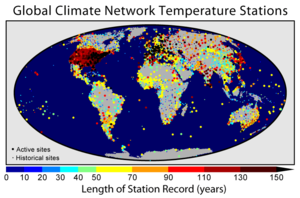
Global Historical Climatology Network
Encyclopedia

Temperature
Temperature is a physical property of matter that quantitatively expresses the common notions of hot and cold. Objects of low temperature are cold, while various degrees of higher temperatures are referred to as warm or hot...
, precipitation
Precipitation (meteorology)
In meteorology, precipitation In meteorology, precipitation In meteorology, precipitation (also known as one of the classes of hydrometeors, which are atmospheric water phenomena is any product of the condensation of atmospheric water vapor that falls under gravity. The main forms of precipitation...
and pressure
Pressure
Pressure is the force per unit area applied in a direction perpendicular to the surface of an object. Gauge pressure is the pressure relative to the local atmospheric or ambient pressure.- Definition :...
records managed by the National Climatic Data Center
National Climatic Data Center
The United States National Climatic Data Center in Asheville, North Carolina is the world's largest active archive of weather data. The center became established in late 1951, with the move into the new facility occurring in early 1952....
, Arizona State University
Arizona State University
Arizona State University is a public research university located in the Phoenix Metropolitan Area of the State of Arizona...
and the Carbon Dioxide Information Analysis Center
Carbon Dioxide Information Analysis Center
The Carbon Dioxide Information Analysis Center is an organization within the United States Department of Energy that has the primary responsibility for providing the US government and research community with global warming data and analysis as it pertains to energy issues...
.
The aggregate data are collected from many continuously reporting fixed stations at the Earth
Earth
Earth is the third planet from the Sun, and the densest and fifth-largest of the eight planets in the Solar System. It is also the largest of the Solar System's four terrestrial planets...
's surface and represent the input of approximately:
- 6000 temperature stations
- 7500 precipitation stations
- 2000 pressure stations
This work is often used as a foundation for reconstructing past global temperatures
Instrumental temperature record
The instrumental temperature record shows fluctuations of the temperature of the global land surface and oceans. This data is collected from several thousand meteorological stations, Antarctic research stations and satellite observations of sea-surface temperature. Currently, the longest-running...
, and is used in two of the official reconstructions, that prepared by the National Climatic Data Center
National Climatic Data Center
The United States National Climatic Data Center in Asheville, North Carolina is the world's largest active archive of weather data. The center became established in late 1951, with the move into the new facility occurring in early 1952....
(NCDC), and that prepared by NASA
NASA
The National Aeronautics and Space Administration is the agency of the United States government that is responsible for the nation's civilian space program and for aeronautics and aerospace research...
as its Goddard Institute for Space Studies
Goddard Institute for Space Studies
The NASA Goddard Institute for Space Studies , at Columbia University in New York City, is a component laboratory of NASA's Goddard Space Flight Center Earth-Sun Exploration Division and a unit of The Earth Institute at Columbia University...
(GISS) temperature set.http://data.giss.nasa.gov/gistemp/ The average temperature record is 60 years long with ~1650 records greater than 100 years and ~220 greater than 150 years (based on GHCN v2 in 2006). The earliest data included in the database were collected in 1697.

